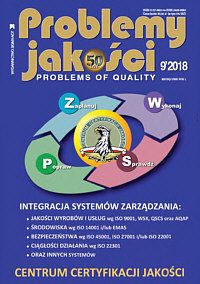
- The use of elements of the quality system in the certification process of the design organization (or product) in accordance with the airworthiness regulations
The intention of the article is to support the implementation of modern airworthiness regulations in the aviation of the Polish Armed Forces. The specific objective is to present proposals for the use of elements of the quality management system in the airworthiness enforcement procedure for the military approval of the designing organization. For this purpose, the standards in the field of Quality Management Systems (QMS) according to ISO and AS and European Military Flightworthiness Requirements (EMAR) were analyzed. The article covers the origin of EMAR requirements, basic EMAR21-J requirements in the area of quality assurance in the Designing Organization (DO) and the certification process. Based on the analysis, the influence of the QMS implemented in the DO system on the certification process according to the airworthiness regulations has been proved.
- Factory Production Control in the SME sector - proposition of the management method
Factory Production Control (FPC) is a quality system that is obligatory for producers of construction products. It should be documented and supervised. The aim of the authors, adopted in the paper, is to identify conditions for FPC documentation, analogies between ZKP and the quality system according to ISO 9001: 2015 and other regulations and to indicate the benefits and difficulties associated with documenting activities and their results. The proposal of a method for managing the documentation of the FPC system was also presented, which - according to the authors - may help smaller organizations plan and implement activities in this area. This proposition is based, among other things, on the results of empirical research that was carried out to determine the needs and problems of FPCs occurring in the group of smaller producers of construction products.
- Analysis and evaluation of software application quality
One of the attributes of the software is the usable quality, evaluated by the end user. It is not a directly measurable quantity. Its level, together with the emergence of new needs on the part of the user, will change, eg in the case of the need to change the interface, introduce new functionalities or improve the software's flexibility. This forces the company management to decide on the software upgrade. However, these activities are expensive, so the decisions made must be highly rational. The aim of the article is to examine software application quality based on the distinguished quality criteria. In the theoretical part, based on a literature query, various models of application quality of software were presented, a method for quantifying quality criteria and determining usable quality measures was presented. In the empirical part, however, the results of customer service quality questionnaire surveys were presented among its users. Based on the results of these studies and statistical analysis, the criteria for the validity of the criteria for the evaluated software were categorized. The presented assessment algorithm allows you to make rational decisions regarding further development work related to the adaptation of this software to the needs of users.
- Quality gap - a determinant of solving problems related to public transport
The aim of the article is to present the role of the quality loop and the quality gap to solve problems in public transport. Thus, the purposefulness of applying the requirements of the PN-EN 13816: 2004 standard was emphasized - Transport - Logistics and services - Public passenger transport - Definitions, objectives and measurements regarding the quality of services. Selected results of the own surveys carried out in the capital city of Warsaw were presented. Recalling relevant literature, including standards, the concept of the quality loop and quality gap and their impact on improving public transport processes were discussed. In the work on the article a research methodology based on questionnaire, deduction, induction, analysis and system synthesis, including requesting, was used.
- Quality assessment of the ecology of an electric car based on energy consumption in real urban traffic
In the case of electric cars, it is not possible to measure exhaust emissions, even if their operation is related to the emission of pollutants during electricity generation. The only information that can be recorded during driving tests in the context of ecological properties is energy consumption. On this basis, one has to conclude about the quality of the car, both economically and indirectly ecological. The article presents the calculation methodology, which on the basis of the speed of the vehicle allows to estimate with which emission of pollutants the operation of an electric vehicle is connected. A comparison of the estimated emission based on the FTP-75 test with the actual emission from the combustion engine in the same test was also presented. Then, the results of road tests were presented, based on which a similar estimation of energy consumption and pollutant emissions was made.
Problemy Jakości (Quality Problems) - full list







